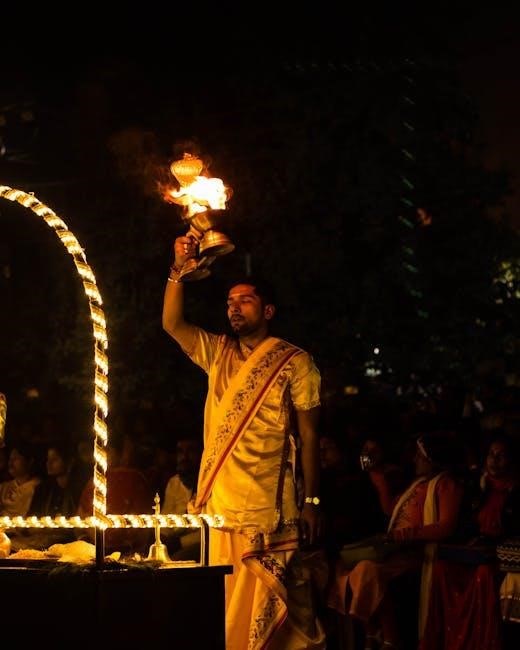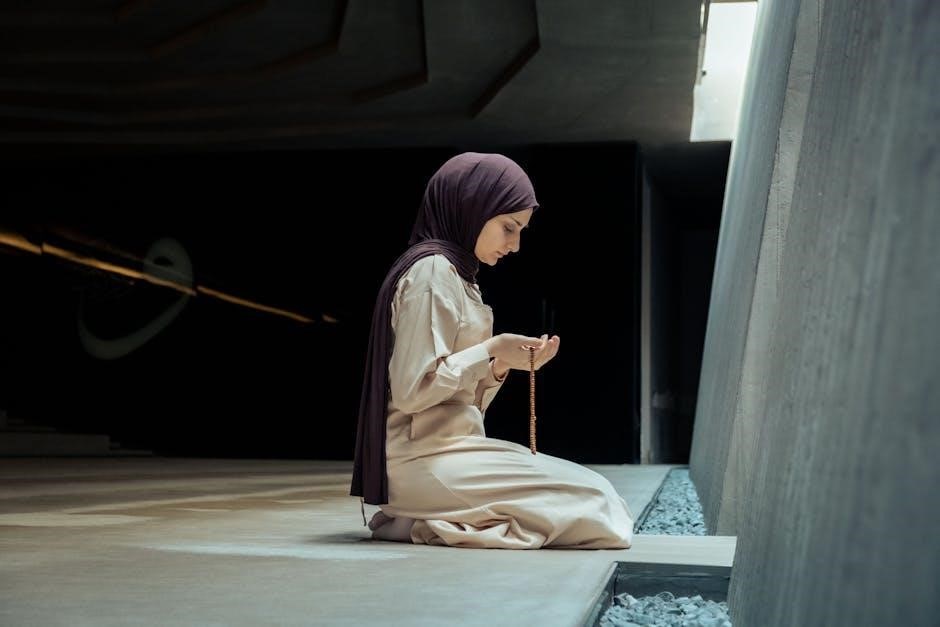
Salat al-Janazah, or the Islamic funeral prayer, is a communal obligation performed to seek forgiveness for the deceased and all Muslims. It is a solemn ritual conducted with specific supplications and takbeers, emphasizing collective spiritual support for the departed soul.
Unlike other prayers, it is performed standing, without ruku or sujud, and is considered a vital act of worship in Islamic tradition, fostering unity and compassion among believers.
Overview of Salat al-Janazah
Salat al-Janazah is a communal Islamic funeral prayer performed to seek forgiveness for the deceased and all Muslims. It is a collective obligation, emphasizing unity and compassion among believers. The prayer is conducted while standing, facing the Qibla, without ruku or sujud. Four takbeers are recited, with specific supplications after each. The first takbeer is followed by Surah al-Fatihah, the second by Darood Ibraheem, and the third by a dua for the deceased. The prayer concludes with salaams, reinforcing the community’s spiritual support for the departed soul and fostering a sense of shared responsibility.
Significance of the Funeral Prayer in Islam
The Funeral Prayer, or Salat al-Janazah, holds profound significance in Islam as a collective supplication for the deceased’s forgiveness and mercy. It is a communal obligation, fostering unity and shared responsibility among believers. The prayer seeks divine pardon for the departed soul and strengthens the bond of faith within the Muslim community; By performing this ritual, participants demonstrate compassion and uphold Islamic traditions, emphasizing the importance of spiritual support in the transition to the afterlife. It also serves as a reminder of life’s transience and the ultimate return to Allah, encouraging believers to reflect on their own faith and deeds.

Steps to Perform the Janazah Prayer
The Janazah Prayer involves preparing the deceased, forming at least three rows, performing four takbeers, reciting specific supplications, and ensuring proper congregational etiquette while standing facing the Qibla.
Preparation of the Deceased
The preparation of the deceased for Janazah Prayer involves washing the body, except for martyrs, by same-gender individuals. The body is then shrouded in a simple, scented kafan. For males, this typically consists of three white, perfumed sheets, ensuring the body is fully concealed. The deceased is then placed on the ground facing the Qibla. This process is a sacred duty, emphasizing dignity and respect. The Imam stands at the head for males and near the abdomen for females, adhering to Islamic etiquette. Proper preparation is essential to honor the deceased and fulfill the communal obligation of the funeral prayer.
Takbeers and Recitations in the Prayer
The Janazah Prayer consists of four Takbeers, each followed by specific recitations. After the first Takbeer, the Thana is recited. The second Takbeer is followed by the Darood Ibraheem. The third Takbeer involves a specific Dua for the deceased, seeking Allah’s forgiveness and mercy. The fourth Takbeer concludes the prayer with the Salaam. These Takbeers and recitations are performed while standing, emphasizing the prayer’s unique structure without ruku or sujud. The recitations are integral to the prayer’s purpose, focusing on seeking divine pardon and comforting the deceased’s soul through collective supplication.
Importance of Congregation in the Prayer
The congregation plays a vital role in the Janazah Prayer, as it is a collective obligation (Fard Kifayah) for Muslims. Gathering in congregation emphasizes unity and solidarity, offering spiritual support to the deceased and their family. The prayer is performed in rows, with the Imam leading at the front. This communal act demonstrates the strength of the Muslim community and its commitment to shared responsibilities. Participating in the congregation is considered a noble act of worship, fostering a sense of togetherness and reinforcing the importance of fulfilling religious duties collectively.

Dua for Janazah Prayer
The Dua in Janazah Prayer is a heartfelt supplication seeking Allah’s forgiveness and mercy for the deceased. It is a central part of the funeral ritual, emphasizing divine compassion and eternal peace for the departed soul, while also uniting the community in collective remembrance and prayer.
Essential Supplications in the Funeral Prayer
The essential supplications in the Janazah prayer include the recitation of Surah Al-Fatihah after the first takbeer, followed by Darood Ibraheem after the second takbeer. The third takbeer is accompanied by a heartfelt dua for the deceased, seeking Allah’s forgiveness and mercy. These supplications are central to the prayer, emphasizing divine compassion and the community’s collective plea for the soul’s peace. They are performed in congregation, fostering unity and spiritual support among the mourners. The supplications are recited in Arabic, reflecting their deep-rooted tradition in Islamic worship. They are a vital part of the funeral ritual, ensuring the deceased is commended to Allah’s care.
Meaning and Translation of Janazah Dua
The Janazah dua is a heartfelt supplication seeking Allah’s forgiveness and mercy for the deceased. It includes prayers like “Allahummaghfir lihayyina wa mayyitina” (O Allah, forgive our living and our dead). Translated, it conveys deep compassion and hope for the soul’s peace. The dua emphasizes divine mercy and the community’s collective plea, reflecting Islamic values of unity and care. Its meaning underscores the belief in Allah’s judgment and the desire for the deceased to be granted eternal peace. The supplications are performed in Arabic, preserving their traditional essence. They are a vital part of the funeral prayer, ensuring the deceased is commended to Allah’s care with sincerity and devotion.
Recommended Dua for the Deceased
Recommended Dua for the Deceased includes specific supplications, such as “Allahummaghfir lihayyina wa mayyitina” (O Allah, forgive our living and our dead) and “Allahummarhamhu” (O Allah, have mercy on him/her). These prayers are recited during the Janazah prayer and are essential for seeking divine forgiveness and mercy for the deceased. They emphasize the community’s collective supplication and compassion. The duas are often included in Janazah prayer guides and are easily accessible in PDF formats, ensuring that everyone can participate meaningfully in the funeral rites. This practice strengthens communal bonds and provides solace to the bereaved.

Availability of Janazah Dua in PDF Format
Janazah Dua is widely available in PDF format, easily downloadable from reputable Islamic websites. These guides provide clear instructions and supplications, ensuring accessibility for all Muslims worldwide.
Downloading Janazah Prayer Dua PDF
Downloading Janazah Prayer Dua in PDF format is straightforward and convenient; Numerous Islamic websites and forums offer free downloadable guides, ensuring easy access for believers worldwide. These PDFs often include step-by-step instructions, Arabic supplications with translations, and essential etiquette for the prayer. They are structured to guide individuals through the preparation, performance, and post-prayer rituals. The digital format allows for easy sharing and printing, making it simpler for Muslims to fulfill their obligation with proper adherence to Islamic traditions. This resource is invaluable for those seeking to participate meaningfully in the Janazah prayer.
Benefits of Using a PDF Guide
Utilizing a PDF guide for Janazah prayer offers numerous advantages, ensuring accuracy and ease of understanding. These guides provide clear instructions, proper Arabic recitations, and their meanings, helping believers perform the prayer correctly. They are accessible anytime, eliminating the need for internet connectivity during rituals. PDFs are easily shareable, enabling community members to prepare collectively. The structured format ensures no essential steps are missed, fostering a sense of confidence and adherence to Islamic traditions. This resource is particularly beneficial for those unfamiliar with the prayer, making it an indispensable tool for spiritual observance.
Popular Websites for Janazah Dua PDF
Several reputable websites offer downloadable Janazah prayer dua PDFs, providing easy access to accurate supplications and instructions. IslamicFinder, MuslimPro, and other trusted platforms feature comprehensive guides, ensuring believers can perform the prayer correctly. These PDFs often include Arabic text, translations, and step-by-step explanations, making them invaluable for both experienced and new practitioners. They are widely shared and downloaded, offering convenience and clarity for those seeking to honor the deceased with proper Islamic rituals.
Common Mistakes to Avoid During Janazah Prayer
- Not facing the Qibla or improper alignment with the deceased’s body.
- Incorrect recitation of specific duas or failure to maintain proper etiquette.
- Imam standing incorrectly relative to the body, especially for males and females.
Forgetfulness of Specific Dua
Forgetting specific duas during the Janazah prayer is a common mistake that can disrupt the prayer’s flow. It is essential to prepare by memorizing or carrying a PDF guide of the Janazah dua to avoid errors. The primary supplications, such as the Thana, Durood, and the final dua for the deceased, must be recited accurately. If forgotten, one should proceed with what is known or remain silent rather than improvise, ensuring the prayer’s integrity is maintained. Proper preparation and practice are key to avoiding such lapses during this solemn ritual.
Incorrect Performance of Takbeers
Mistakes during the takbeers in the Janazah prayer, such as incorrect numbering or improper sequence, can invalidate the prayer. Each of the four takbeers must be performed distinctly, with specific recitations following each. Misreciting or omitting parts of the takbeers disrupts the prayer’s structure. It is crucial to adhere to the correct order: Takbeer al-Ihraam, followed by Thana, Durood, and the final dua for the deceased. Using a PDF guide can help ensure accuracy and prevent errors, safeguarding the prayer’s validity and maintaining its spiritual significance.
Non-Adherence to Congregational Rules
Failing to follow congregational rules during Janazah prayer, such as incorrect positioning or not forming proper rows, can disrupt the prayer’s unity and validity. The Imam must stand at the correct position relative to the deceased, and the congregation should align in straight, orderly rows. Neglecting these rules can lead to spiritual shortcomings and diminish the collective benefit of the prayer. Ensuring adherence to these guidelines is essential for maintaining the prayer’s integrity and maximizing its spiritual impact. Using a Janazah dua PDF guide can help participants understand and follow these rules accurately.
Importance of Dua in Janazah Prayer
Dua in Janazah prayer is a heartfelt supplication seeking forgiveness and comfort for the deceased and their loved ones. It reflects the community’s collective spiritual support.
Reciting specific duas, as guided by Islamic tradition, ensures the prayer’s efficacy and fosters unity among believers, emphasizing the importance of seeking divine mercy for the departed soul.
Spiritual Benefits for the Deceased
The Janazah prayer offers profound spiritual benefits for the deceased, seeking forgiveness and mercy from Allah. The collective supplication of the congregation creates a powerful appeal for the soul’s ease in the afterlife.
Reciting specific duas, such as those found in the Janazah prayer PDF, is believed to provide comfort to the deceased and assist in their journey to the hereafter. This act of worship highlights the community’s care and spiritual support, embodying Islam’s emphasis on collective compassion and divine intercession for the departed soul.
Collective Supplication for Forgiveness
The Janazah prayer du’a, as detailed in the PDF, involves a heartfelt collective supplication for forgiveness, uniting the congregation in seeking Allah’s mercy for the deceased. This unified appeal strengthens the community’s spiritual bond and amplifies the prayer’s efficacy.
By reciting the prescribed duas together, the worshippers not only honor the departed but also demonstrate their faith in divine compassion. This collective effort reflects Islam’s value on communal worship and mutual support, offering solace to the bereaved while seeking divine pardon for the deceased soul.
Strengthening Community Bonds
The Janazah prayer fosters a sense of unity and solidarity among Muslims, as the congregation gathers to support the deceased’s family and seek forgiveness for the soul. This collective act of worship strengthens communal ties and reinforces the importance of mutual support in times of grief.
By participating in the prayer, believers share in the responsibility of comforting the bereaved and upholding Islamic traditions. The shared experience of reciting specific duas and performing the ritual together creates a profound sense of togetherness, highlighting the value Islam places on community and collective spiritual growth.

Role of the Imam in Janazah Prayer
The Imam leads the congregation, standing at the head of the deceased for males and near the abdomen for females, guiding the prayer with specific recitations and ensuring proper etiquette is maintained throughout the ritual.
Leading the Congregation
The Imam assumes a vital role in leading the Janazah prayer, ensuring the congregation aligns with Islamic traditions. Standing at the head of the deceased for males and near the abdomen for females, the Imam guides the prayer with a calm and respectful demeanor. They recite the takbeers and essential supplications, maintaining the correct order and rhythm. The Imam’s leadership ensures unity and harmony among the worshippers, fostering a collective spiritual focus on seeking forgiveness for the deceased. Proper positioning and clear recitation are essential to uphold the prayer’s sanctity and communal intention.
Recitation of Specific Surahs and Dua
In the Janazah prayer, the Imam recites specific supplications and surahs, beginning with the first takbeer, followed by Surah al-Fatihah and Darood Ibraheem. After the second takbeer, a dua for the deceased is recited, seeking forgiveness and mercy. The fourth takbeer concludes with a final supplication for the deceased and the Muslim community. These recitations are performed in a specific order, emphasizing the prayer’s spiritual purpose. PDF guides often include these duas and surahs, ensuring their correct recitation and helping worshippers follow the Imam seamlessly during the prayer.
Ensuring Proper Etiquette
During the Janazah prayer, the Imam ensures proper etiquette by standing level with the head of the deceased (for males) or the abdomen (for females), facing the Qibla. The congregation must maintain silence, avoid unnecessary movements, and form straight, evenly spaced rows. The Imam leads the prayer with dignity, reciting the specific duas and surahs in the correct order. Proper etiquette also includes ensuring the deceased is appropriately shrouded and positioned. PDF guides often outline these etiquette norms, helping participants adhere to the Sunnah and maintain the prayer’s solemnity and decorum.
Janazah Prayer and Islamic Funeral Rituals
Islamic funeral rituals include Ghusl (washing the body), shrouding in Kafan, and transportation to the cemetery. The Janazah prayer is performed before burial, seeking forgiveness for the deceased.
Ghusl and Shrouding of the Body
Ghusl involves washing the deceased with water and perfume, ensuring purification before burial. Martyrs are exempt from this ritual. The body is then wrapped in a simple, white Kafan, avoiding elaborate designs. For males, three large, perfumed sheets are used, while females may have an additional covering. The Kafan must cover the entire body modestly. This process is performed by same-gender individuals, reflecting Islamic modesty and respect. The body is later placed facing Qibla during the Janazah prayer, symbolizing unity in faith and preparation for the final journey.
Transportation to the Cemetery
After the Janazah prayer, the deceased is transported to the cemetery with dignity. The process is simple and quick, reflecting Islamic modesty. Relatives and community members often assist, ensuring the body is handled with respect. The transportation should be arranged in advance, especially if the cemetery is distant. The body is placed in a vehicle, typically facing Qibla, to maintain directional alignment with Islamic tradition. This step emphasizes the community’s collective responsibility in fulfilling the deceased’s final rites, ensuring a respectful and efficient transition to the burial site.
Burial and Final Prayers
The burial follows immediately after the Janazah prayer. The deceased is placed in the grave facing Qibla, with the head towards the right for men and the left for women. The body is lowered by same-gender individuals, who also fill the grave with soil. The grave is typically simple, reflecting humility. Final supplications are recited, seeking Allah’s mercy and forgiveness for the deceased. The community gathers to offer condolences, emphasizing collective support and spiritual closure. This final act completes the Islamic funeral rites, ensuring the departed is laid to rest with dignity and according to tradition.